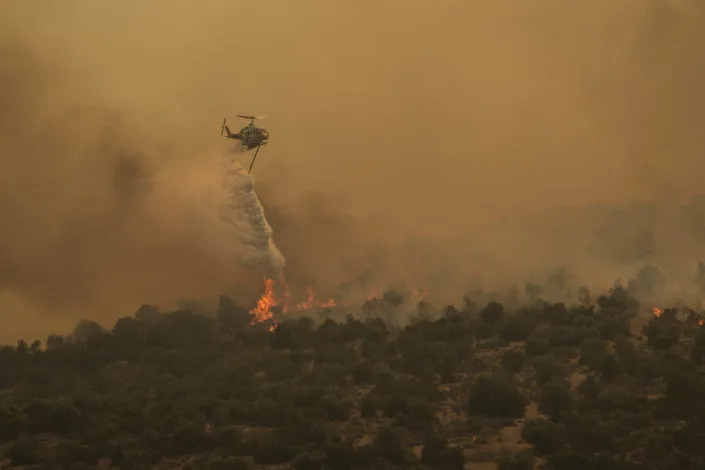WE ARE ALL FROGS IN THE POT
July has been so blistering hot, scientists already calculate that it's the warmest month on recordSETH BORENSTEIN
Updated Thu, July 27, 2023
WASHINGTON (AP) — July has been so hot thus far that scientists calculate that this month will be the hottest globally on record and likely the warmest human civilization has seen, even though there are several days left to sweat through.
The World Meteorological Organization and the European Union’s Copernicus Climate Change Service on Thursday proclaimed July’s heat is beyond record-smashing. They said Earth’s temperature has been temporarily passing over a key warming threshold: the internationally accepted goal of limiting global warming to 1.5 degree Celsius (2.7 degrees Fahrenheit).
Temperatures were 1.5 degrees warmer than pre-industrial times for a record 16 days this month, but the Paris climate accord aims to keep the 20- or 30-year global temperature average to 1.5 degrees. A few days of temporarily beating that threshold have happened before, but never in July.
July has been so off-the-charts hot with heat waves blistering three continents – North America, Europe and Asia – that researchers said a record was inevitable. The U.S. Southwest's all-month heat wave is showing no signs of stopping while also pushing into most of the Midwest and East with more than 128 million Americans under some kind of heat advisory Thursday.
“Unless an ice age were to appear all of sudden out of nothing, it is basically virtually certain we will break the record for the warmest July on record and the warmest month on record,” Copernicus Director Carlo Buontempo told The Associated Press.
Scientists say that such shattering of heat records is a harbinger for future climate-altering changes as the planet warms. Those changes go beyond just prolonged heat waves and include more flooding, longer-burning wildfires and extreme weather events that put many people at risk.
United Nations Secretary-General Antonio Guterres pointed to the calculations and urged world leaders, in particular of rich nations, to do more to reduce emissions of heat-trapping gases. Despite years of international climate negotiations and lofty pledges from many countries and companies, greenhouse gas emissions continue to go up.
“Climate change is here. It is terrifying. And it is just the beginning,” Guterres told reporters in a New York briefing. “The era of global warming has ended; the era of global boiling has arrived.”
Buontempo and other scientists said the records are from human-caused climate change augmented by a natural El Nino warming of parts of the central Pacific that changes weather worldwide. But Buontempo said ocean warming in the Atlantic also has been so high — though far away from the El Nino — that's there's even more at play. While scientists long predicted the world would continue to warm and have bouts of extreme weather, he said he was surprised by the spike in ocean temperatures and record-shattering loss of sea ice in Antarctica.
"The climate seems to be going crazy at times," Buontempo said.
Copernicus calculated that through the first 23 days of July, Earth’s temperature averaged 16.95 degrees Celsius ( 62.5 degrees Fahrenheit). That’s nearly one-third of a degree Celsius (almost 0.6 degrees Fahrenheit) hotter than the previous record for the hottest month, July 2019.
Normally records are broken by hundredths of a degree Celsius, maybe a tenth at most, said Russell Vose, climate analysis group director for the U.S. National Oceanic and Atmospheric Administration.
Usually records aren't calculated until a week or longer after a month's end. But Vose, who wasn’t part of the research, his NASA record-keeping counterpart Gavin Schmidt and six other outside scientists said the Copernicus calculations make sense.
Buontempo’s team found that 21 of the first 23 days of July were hotter than any previous days in the database.
“The last few weeks have been rather remarkable and unprecedented in our record” based on data that goes back to the 1940s, Buontempo said.
Both the WMO-Copernicus team and an independent German scientist who released his data at the same time came to these conclusions by analyzing forecasts, live observations, past records and computer simulations.
Separate from Copernicus, Karsten Haustein at Leipzig University did his own calculations, using forecasts that show at best the warming may weaken a tad at the end of month, and came to the conclusion that July 2023 will pass the old record by 0.2 degrees Celsius (.36 degrees Fahrenheit).
“It’s way beyond everything we see,” Haustein said in his own press briefing. “We are in absolutely new record territory.”
Haustein said even though records only go back to the middle of the 19th century, using tree rings, ice cores and other proxies he calculates that this month is the hottest in about 120,000 years, which Buontempo said makes sense. Other scientists have made similar calculations.
“The reason that setting new temperature records is a big deal is that we are now being challenged to find ways to survive through temperatures hotter than any of us have ever experienced before,” University of Wisconsin-Madison climate scientist Andrea Dutton said in an email. “Soaring temperatures place ever increasing strains not just on power grids and infrastructure, but on human bodies that are not equipped to survive some of the extreme heat we are already experiencing.”
It’s no accident that the hottest July on record has brought deadly heat waves in the U.S. and Mexico, China and southern Europe, smoke-causing wildfires and heavy floods worldwide, said Imperial College of London climate scientist Friederike Otto.
The average temperature being measured is like “the fever temperature that we measure for our planet,” Otto said.
“We are in uncharted territory as far as humans on this planet are concerned, so our records are falling with increasing frequency and that’s exactly what we expect to — and what we’ve been predicting would — happen,” said Texas Tech climate scientist Katharine Hayhoe.
In the middle of some of the worst heat, where Phoenix is now at a record 27 straight days and counting of 110 degrees or higher temperatures, University of Arizona climate scientist Katharine Jacobs said the records are giving humanity a message about reducing emissions of heat-trapping gases from the burning of coal, oil and natural gas.
“Events like this are signposts along a highway we don’t want to travel,” Jacobs said in an email. “It is time to stop playing political games and get serious in order to protect ourselves and future generations.
___
Jamey Keaten contributed from Geneva and Edith Lederer from the United Nations.
___
Follow AP’s climate and environment coverage at https://apnews.com/hub/climate-and-environment
___
Follow Seth Borenstein on Twitter at @borenbears
___
Associated Press climate and environmental coverage receives support from several private foundations. See more about AP’s climate initiative here. The AP is solely responsible for all content.
World is entering ‘era of global boiling’, UN warns as July is the hottest month on record
Louise Boyle
Thu, July 27, 2023 a

July is set to be the hottest month on record - and likely in 120,000 years. From left: A firefighter tackles flames in Rhodes; A man soaks himself in water in Zagreb, Croatia as it hit 40C; A bus trapped by flash flooding in Osong, South Korea. Inset, a graph showing global temperature rise (epa/AP)
The warning lights have been on for weeks but now it is official: July 2023 is set to be the hottest month on record - and likely in 120,000 years.
The record-breaking average global mean temperature - the overall reading if you could stick a thermometer at every location on Earth - was confirmed by scientists at the European Copernicus Climate Change Service and World Meteorological Organization on Thursday, based on analysis of international climate and weather datasets.
“Climate change is here. It is terrifying. And it is just the beginning,” United Nations Secretary-General Antonio Guterres said on Thursday morning in New York.
“The era of global warming has ended; the era of global boiling has arrived.”
Dr Karsten Haustein, a climate scientist at Leipzig University whose separate analysis was first to confirm the new record, told a press briefing on Wednesday that July 2023 was also likely the warmest in 120,000 years, stretching back to the interglacial Eemian period when hardwood trees grew in the Arctic and hippos roamed as far north as the Rhine and Thames valleys.
It follows the hottest June on record, and toppling of the hottest day records, multiple times, in early July.
The overall mean temperature, which scientists say is around 17C (62.6F), isn’t going to kill anyone but it means that the planet has a “fever”, said Dr Frederike Otto, senior lecturer at the Grantham Institute for Climate Change.
July 2023 is set to be the hottest month on record, and likely in 120,000 years. The record-breaking average global mean temperature, the overall reading if you could stick a thermometer at every location on Earth, was confirmed by scientists, including at the European Copernicus Climate Change Service and World Meteorological Organisation on Thursday, based on analysis of international climate and weather datasets. Senior climate correspondent Louise Boyle reports on the findings. #fypシ #fy #fyp #news #climate #world #heat #weather♬ original sound - The Independent
The increase in global heat is manifesting in extreme weather events worldwide. Southern Europe, North Africa and Asia have faced relentless heatwaves since late spring, and in the southern United States, temperatures have regularly topped 100-degrees for weeks.
Phoenix, Arizona had a record-breaking 19 days in a row above 110F this month while China set a new national temperature record of 52.2C on 16 July in Xinjiang province.

Global daily surface air temperature (in Celsius) from 1 January 1940- 23 July 2023. This year and 2016 are thick lines shaded in bright red and dark red, respectively. Other years are shown with thin lines and shaded according to the decade, from blue (1940s) to brick red (2020s). The dotted line and grey envelope represent the 1.5C threshold above preindustrial level (1850–1900) and its uncertainty

A person receives medical attention after collapsing in a convenience store on July 13, 2023 in Phoenix, Arizona. EMT was called after the person said they experienced hot flashes, dizziness, fatigue and chest pain. The temperature has been above 110F in Phoenix for most of July
Louise Boyle
Thu, July 27, 2023 a

July is set to be the hottest month on record - and likely in 120,000 years. From left: A firefighter tackles flames in Rhodes; A man soaks himself in water in Zagreb, Croatia as it hit 40C; A bus trapped by flash flooding in Osong, South Korea. Inset, a graph showing global temperature rise (epa/AP)
The warning lights have been on for weeks but now it is official: July 2023 is set to be the hottest month on record - and likely in 120,000 years.
The record-breaking average global mean temperature - the overall reading if you could stick a thermometer at every location on Earth - was confirmed by scientists at the European Copernicus Climate Change Service and World Meteorological Organization on Thursday, based on analysis of international climate and weather datasets.
“Climate change is here. It is terrifying. And it is just the beginning,” United Nations Secretary-General Antonio Guterres said on Thursday morning in New York.
“The era of global warming has ended; the era of global boiling has arrived.”
Dr Karsten Haustein, a climate scientist at Leipzig University whose separate analysis was first to confirm the new record, told a press briefing on Wednesday that July 2023 was also likely the warmest in 120,000 years, stretching back to the interglacial Eemian period when hardwood trees grew in the Arctic and hippos roamed as far north as the Rhine and Thames valleys.
It follows the hottest June on record, and toppling of the hottest day records, multiple times, in early July.
The overall mean temperature, which scientists say is around 17C (62.6F), isn’t going to kill anyone but it means that the planet has a “fever”, said Dr Frederike Otto, senior lecturer at the Grantham Institute for Climate Change.
July 2023 is set to be the hottest month on record, and likely in 120,000 years. The record-breaking average global mean temperature, the overall reading if you could stick a thermometer at every location on Earth, was confirmed by scientists, including at the European Copernicus Climate Change Service and World Meteorological Organisation on Thursday, based on analysis of international climate and weather datasets. Senior climate correspondent Louise Boyle reports on the findings. #fypシ #fy #fyp #news #climate #world #heat #weather♬ original sound - The Independent
The increase in global heat is manifesting in extreme weather events worldwide. Southern Europe, North Africa and Asia have faced relentless heatwaves since late spring, and in the southern United States, temperatures have regularly topped 100-degrees for weeks.
Phoenix, Arizona had a record-breaking 19 days in a row above 110F this month while China set a new national temperature record of 52.2C on 16 July in Xinjiang province.

Global daily surface air temperature (in Celsius) from 1 January 1940- 23 July 2023. This year and 2016 are thick lines shaded in bright red and dark red, respectively. Other years are shown with thin lines and shaded according to the decade, from blue (1940s) to brick red (2020s). The dotted line and grey envelope represent the 1.5C threshold above preindustrial level (1850–1900) and its uncertainty
(Copernicus/WMO)More
Wildfires have exploded across Greece, Italy, Croatia and Algeria. In Canada, there are now more than 1,000 wildfires, doubling the amount four weeks ago, which have destroyed 46,000 square miles - an area half the size of the UK.
The extreme heat is also playing out in intense, erratic rainfall which has led to deadly flash flooding in China, South Korea, Brazil and US Northeast.
The 2023 July record also came with a public health warning.
Heatwaves are known as “silent killers” and are the deadliest of all climate-driven disasters. Extreme temperatures contributed to more than 60,000 deaths in Europe alone last year.
These deaths are most often among society’s already vulnerable groups, and an aging global population along with growing cities - which can be much hotter than rural places - means that “heat deaths will only increase,” Dr Otto said.

A firefighting helicopter dumps water in Mandra, west of Athens, on Tuesday, July 18, 2023. Another heatwave is expected to hit Greece today (AP)
Dr Marina Romanello, a climate change and health researcher at UCL, said the record heat was “rapidly undermining the foundations of health” and placing more burdens on many countries’ already over-stretched healthcare systems.
Heat-related mortality for those over 65 years old has risen by about two-thirds in the past 20 years meanwhile, wildfire exposure has increased in 60 per cent of countries.
Almost a third of global land area is affected by drought annually compared to the 1950s, with the Horn of Africa and South America being particularly vulnerable. These conditions are pushing tens of millions more people into extreme hunger.
This year’s extreme heat is being amplified by the emergence of a natural climatic pattern, El Nino, which leads to hotter ocean temperatures. Since May, record sea surface temperatures have driven marine heatwaves in the Mediterranean, the UK and Ireland, the Baltic Sea, the Sea of Japan along with parts of the Pacific and western Indian Ocean.
But without a manmade climate crisis, “these heatwaves would be the statistical equivalent of impossible,” Dr Otto said.
The hottest month on record is a direct result of the burning and extraction of coal, oil and gas. We need to accelerate the clean energy transition to draw back from this runaway climate crisis.
Dr Catherine Abreu, executive director of Destination Zero
“This is not chance. These are not rare events in today’s climate.”
If El Nino intensifies, it’s possible that next summer will be even hotter.
In the first and third weeks of July, the planet shot 1.5-degrees (2.7F) above the average temperature 150 years ago - before humans began burning massive amounts of fossil fuels.
It doesn’t mean that the planet will permanently exceed 1.5C - the temperature limit set by the Paris Agreement which refers to long-term warming - but shows “we are close” and that 1.5C will likely be permanently breached in the early 2030s, Dr Haustein said.
The culprit of all this extreme heat are the excessive emissions from burning fossil fuels.
“We know who is responsible,” said Dr Catherine Abreu, executive director of Destination Zero, a diplomatic initiative focused on limiting fossil fuel production.
She pointed to a few dozen major players in oil, gas and coal, along with large cement-makers, adding that the fossil fuel industry has “known for decades” about the impacts their products would have on the planet.
Wildfires have exploded across Greece, Italy, Croatia and Algeria. In Canada, there are now more than 1,000 wildfires, doubling the amount four weeks ago, which have destroyed 46,000 square miles - an area half the size of the UK.
The extreme heat is also playing out in intense, erratic rainfall which has led to deadly flash flooding in China, South Korea, Brazil and US Northeast.
The 2023 July record also came with a public health warning.
Heatwaves are known as “silent killers” and are the deadliest of all climate-driven disasters. Extreme temperatures contributed to more than 60,000 deaths in Europe alone last year.
These deaths are most often among society’s already vulnerable groups, and an aging global population along with growing cities - which can be much hotter than rural places - means that “heat deaths will only increase,” Dr Otto said.

A firefighting helicopter dumps water in Mandra, west of Athens, on Tuesday, July 18, 2023. Another heatwave is expected to hit Greece today (AP)
Dr Marina Romanello, a climate change and health researcher at UCL, said the record heat was “rapidly undermining the foundations of health” and placing more burdens on many countries’ already over-stretched healthcare systems.
Heat-related mortality for those over 65 years old has risen by about two-thirds in the past 20 years meanwhile, wildfire exposure has increased in 60 per cent of countries.
Almost a third of global land area is affected by drought annually compared to the 1950s, with the Horn of Africa and South America being particularly vulnerable. These conditions are pushing tens of millions more people into extreme hunger.
This year’s extreme heat is being amplified by the emergence of a natural climatic pattern, El Nino, which leads to hotter ocean temperatures. Since May, record sea surface temperatures have driven marine heatwaves in the Mediterranean, the UK and Ireland, the Baltic Sea, the Sea of Japan along with parts of the Pacific and western Indian Ocean.
But without a manmade climate crisis, “these heatwaves would be the statistical equivalent of impossible,” Dr Otto said.
The hottest month on record is a direct result of the burning and extraction of coal, oil and gas. We need to accelerate the clean energy transition to draw back from this runaway climate crisis.
Dr Catherine Abreu, executive director of Destination Zero
“This is not chance. These are not rare events in today’s climate.”
If El Nino intensifies, it’s possible that next summer will be even hotter.
In the first and third weeks of July, the planet shot 1.5-degrees (2.7F) above the average temperature 150 years ago - before humans began burning massive amounts of fossil fuels.
It doesn’t mean that the planet will permanently exceed 1.5C - the temperature limit set by the Paris Agreement which refers to long-term warming - but shows “we are close” and that 1.5C will likely be permanently breached in the early 2030s, Dr Haustein said.
The culprit of all this extreme heat are the excessive emissions from burning fossil fuels.
“We know who is responsible,” said Dr Catherine Abreu, executive director of Destination Zero, a diplomatic initiative focused on limiting fossil fuel production.
She pointed to a few dozen major players in oil, gas and coal, along with large cement-makers, adding that the fossil fuel industry has “known for decades” about the impacts their products would have on the planet.

A person receives medical attention after collapsing in a convenience store on July 13, 2023 in Phoenix, Arizona. EMT was called after the person said they experienced hot flashes, dizziness, fatigue and chest pain. The temperature has been above 110F in Phoenix for most of July
(Getty Images)
“The hottest month on record is a direct result of the burning and extraction of coal, oil and gas,” she added. “We need to accelerate the clean energy transition to draw back from this runaway climate crisis.”
But even as scientists sound the alarm, again, political and corporate will to tackle the global crisis is lagging.
The global fossil fuel industry more than doubled their profits to $4 trillion in 2022 but little of this money has been used to transition away from oil and gas to clean energy.
At the geopolitical level, progress is grindingly slow. Last weekend’s meeting of energy ministers from the G20 - the world’s 20 richest countries - ended with failure to reach consensus on cutting down fossil fuels and a walk-back on commitments made in 2022.
Many governments are still prioritising, and subsidising, the oil and gas industry over healthcare, Dr Romanello said, and the global carbon price is still negative.
According to the 2022 Lancet Countdown report, led by Dr Romanello, in the majority of 86 countries creating the bulk of global emissions, the net cost of fossil fuel subsidies is $400bn. For one-third of these countries, their losses exceed what they spent on healthcare.
The new July record raises the prospect that 2023 could be the hottest year in human history, a record that is unlikely to hold for long.
“The extreme weather which has affected many millions of people in July is unfortunately the harsh reality of climate change and a foretaste of the future,” said WMO’s Secretary-General Prof. Petteri Taalas.
“The need to reduce greenhouse gas emissions is more urgent than ever before. Climate action is not a luxury but a must.”
“The hottest month on record is a direct result of the burning and extraction of coal, oil and gas,” she added. “We need to accelerate the clean energy transition to draw back from this runaway climate crisis.”
But even as scientists sound the alarm, again, political and corporate will to tackle the global crisis is lagging.
The global fossil fuel industry more than doubled their profits to $4 trillion in 2022 but little of this money has been used to transition away from oil and gas to clean energy.
At the geopolitical level, progress is grindingly slow. Last weekend’s meeting of energy ministers from the G20 - the world’s 20 richest countries - ended with failure to reach consensus on cutting down fossil fuels and a walk-back on commitments made in 2022.
Many governments are still prioritising, and subsidising, the oil and gas industry over healthcare, Dr Romanello said, and the global carbon price is still negative.
According to the 2022 Lancet Countdown report, led by Dr Romanello, in the majority of 86 countries creating the bulk of global emissions, the net cost of fossil fuel subsidies is $400bn. For one-third of these countries, their losses exceed what they spent on healthcare.
The new July record raises the prospect that 2023 could be the hottest year in human history, a record that is unlikely to hold for long.
“The extreme weather which has affected many millions of people in July is unfortunately the harsh reality of climate change and a foretaste of the future,” said WMO’s Secretary-General Prof. Petteri Taalas.
“The need to reduce greenhouse gas emissions is more urgent than ever before. Climate action is not a luxury but a must.”


































